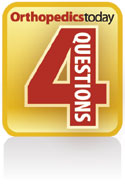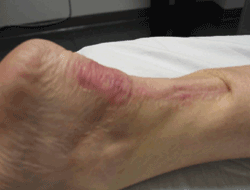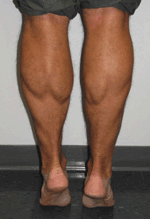Treating the acute disruption of the Achilles tendon: The nonoperative option
In this 4 Questions interview, Kevin R. Willits, MA, MD, FRSCC, explains the recent study examining nonoperative treatment with aggressive rehabilitation and its best indications.

Introduction
Most orthopedic surgeons who treat acute ruptures of the Achilles tendon have a preferred method of treatment and are satisfied by their patient outcomes. Kevin R. Willits, MA, MD, FRSCC, and his colleagues have recently published an excellent article in The Journal of Bone and Joint Surgery that will challenge many of your current concepts. Needless to say, it would be ideal to often avoid the hypertrophic scar and surgery itself if the outcomes from an acute Achilles tendon rupture could be the same.
I am pleased to share Dr. Willit’s responses to our 4 Questions this month. In addition, I would encourage those of you that wish more details to read the article which I found to be very interesting.
Douglas W. Jackson, MD
Chief Medical Editor
Douglas W. Jackson, MD: The re-rupture rate and full return of subsequent explosive power have been reasons surgeons have preferred the surgical repair of acute Achilles tendon ruptures. What was confusion in the literature and the basis that prompted you to further investigate the nonoperative treatment of these injuries?
|
Image: Willits KR |
Kevin R. Willits MA, MD, FRSCC: The basis for us to further investigate nonoperative treatment of Achilles tendon ruptures evolved around the fact that many of the studies in the literature that had concluded nonoperative treatment was inferior to surgical repair utilized very conservative rehab protocols. We felt there was a possibility that a more aggressive functional rehabilitation program could yield better and perhaps comparable results to operative treatment.
The other factor that we considered was the conflicting results in the literature with some studies suggesting nonoperative treatment to be equivalent to operative treatment despite using conservative rehab protocols. We felt there were few high-quality trials that had been directed at this important question and that more investigation was required. In order to answer this question, a tightly controlled, comprehensive, high-quality investigation was required.
Jackson: What type of study and methodology did your group design to evaluate this issue?
Willits: Our study utilized a prospective, randomized control trial design to answer the question of whether operative treatment results in improved outcome following acute Achilles tendon ruptures. All patients with this diagnosis were randomized to receive either operative repair of the tendon or nonoperative treatment utilizing an accelerated rehabilitation program. The only difference in the two groups was whether they underwent surgical repair.
Jackson: How do you define accelerated functional rehabilitation of an acute Achilles tendon injury?
Willits: Our definition of accelerated functional rehabilitation is the inclusion of early weight-bearing and motion. These two aspects have been shown in other applications to promote tendon healing that more closely resembles normal collagen. When we designed the rehabilitation protocol for this study we were somewhat concerned that the protocol was in fact too aggressive, given other protocols that focused on cast immobilization and nonweight-bearing. Fortunately, the application of this type of protocol did not result in an increased re-rupture rate as was our fear, but in fact, lessened the rate of re-rupture seen in earlier studies.
|
|
In our study all patients were immobilized in 20° of plantarflexion in a posterior back slab splint and were nonweight-bearing for 2 weeks following their injury. Both groups of patients were then converted to a boot orthosis with a 2-cm heel lift and allowed to perform protected weight-bearing as tolerated. All patients continued to use the boot orthosis with the heel lift until they reached the 6-week post-injury mark, at which time the lift was removed. Patients were then allowed to wean out of the boot entirely at 8 weeks post injury.
The rehabilitation protocol also included range of motion to neutral dorsiflexion at 2 weeks and advanced as tolerated at the 6 week mark.
The authors of this study feel strongly the inclusion of this early range of motion and weight-bearing protocol is critical to the results seen in this investigation.
Jackson: What do you recommend to an athletic patient with an acute Achilles tendon disruption who wants to return to unrestricted training and performance?
Willits: Given the results of this trial, I currently recommend nonoperative treatment and accelerated functional rehabilitation to athletic patients who wish to return to full training and competition. Although the recovery from this injury can be prolonged, this trial indicates that the recovery is equivalent to operative management without the risk of complications that could further delay or prevent full recovery. There is still much work to be done regarding minimizing the time to full recovery following an Achilles tendon rupture and that is the focus of our ongoing research in this area.
Reference:
- Willits K, et al. Operative versus nonoperative treatment of acute achilles tendon ruptures, J Joint Bone Surg (Am). 2010;92:2767-2775.
- Kevin R. Willits MA, MD, FRSCC, is an associate professor of orthopedic surgery at Fowler Kennedy Sport Medicine Clinic at the University of Western Ontario. He can be reached at 3M Centre, London, Ontario, Canada N6A 3K; e-mail: kwillits2001@yahoo.ca.


